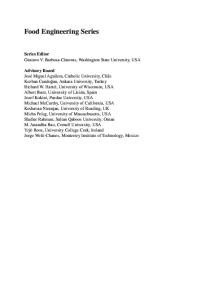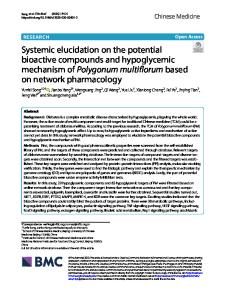Bioactive and functional compounds of mixed beverages based on fruits and vegetables
- PDF / 1,337,470 Bytes
- 9 Pages / 595.276 x 790.866 pts Page_size
- 75 Downloads / 363 Views
Bioactive and functional compounds of mixed beverages based on fruits and vegetables Patrícia da Silva Machado1 · Rafaela da Silva Melo1 · Ana Beatriz Silva Araújo1 · Taciene Carvalho Mesquita1 · Ítalo Careli Gondim1 · Elídio Zaidine Maurício Zitha1 · Elisângela Elena Nunes Carvalho1 · Eduardo Valério de Barros Vilas Boas1 · Luiz Carlos de Oliveira Lima1 Received: 8 August 2019 / Accepted: 28 November 2019 © Springer Nature Switzerland AG 2020
Abstract In recent years, the demand for fruits and vegetables has increased in several countries. Thereby, the consumption of natural beverages increased, and specifically those with claims of functional properties. However, there is a clear need for further studies on the beneficial effects of these beverages, and greater attention should be given to brands that use this information in a manner that is unconcerned with consumer health. This work aimed to study the physical–chemical composition and bioactive and functional compounds of some brands of natural drinks marketed in Brazil. Six brands of natural drinks were acquired and analyzed for pH, titratable acidity (%), soluble solids, total sugars, color, total phenolics, vitamin C, β-carotene/linoleic acid, DPPH and dietary fiber. The drinks analyzed are in accordance with the literature for acidity, except the ‘E’ brand. The sugar content found in three brands (‘A,’ ‘B-Le’ and ‘D’) was higher than reported on the labels, and the ‘A’ brand misleads the consumer by stating that their drink is ‘zero sugar.’ In general, the drinks showed yellowish color, except the ‘E’ brand with greenish coloration. The brand ‘A’ also had higher levels of vitamin C than established by law. The amount of phenolic compounds was higher in the ‘A’ and ‘F’ brands. The antioxidant content was higher in ‘A,’ ‘C’ and ‘F.’ The ‘D’ and ‘F’ brands were shown as sources of dietary fiber. The content of some brands analyzed is in disagreement with their labels which represents a danger to consumers with some kind of food restriction. Keywords Juice · Antioxidants · Dietary fiber · Detox · DPPH JEL Classification I11 Mathematics Subject Classification 92-02
1 Introduction Demand for fruit and vegetables has increased in recent years in several countries in response to increased public awareness of the benefits of healthy eating. It has been suggested that consumption of antioxidant-rich foods may delay or prevent many diseases [1, 2]. Therefore, the guide to health promotion and disease prevention in the
USA and around the world includes recommendations for daily consumption of a variety of fruits and vegetables, since they have significant amounts of bioactive compounds, especially vitamins, minerals and fiber [3]. To help ingesting adequate amounts of fruits and vegetables, juices are a practical alternative [4]. In order to increase the consumption of natural drinks, fruit juice companies are expanding their niche markets
* Patrícia da Silva Machado, [email protected] | 1Federal University of Lavras, UFLA, University Campus, Cx.
Data Loading...











